Architecture of Computer System: Components, Memory, and Data Conversion
Added on 2022-12-26
22 Pages3630 Words60 Views
UNIT 37: ARCHITECTURE
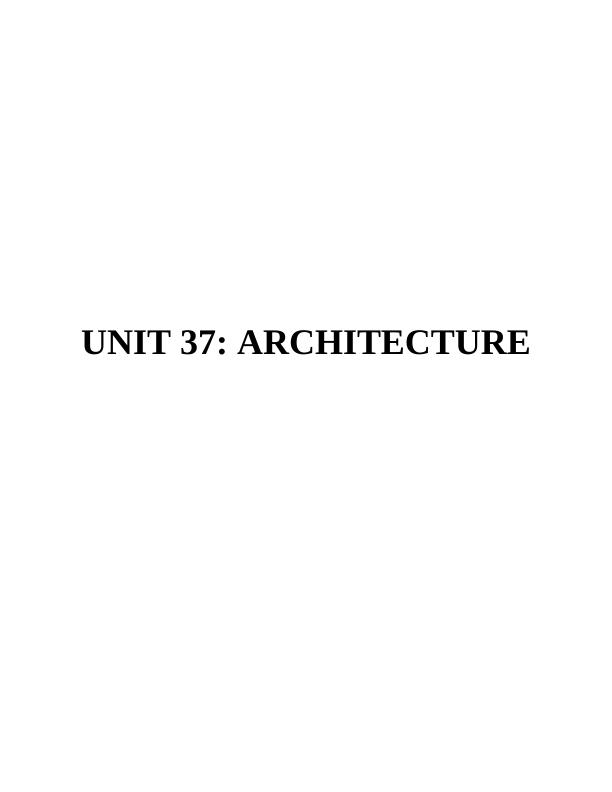
TABLE OF CONTENTS
INTRODUCTION...........................................................................................................................3
LO 1.................................................................................................................................................3
P1 Components of computer system and the interrelationship between them............................3
P2 Ways in which different types of memory is attached to the processor.................................8
LO 2...............................................................................................................................................11
P3Ways in which data is converted and stored in computer systems........................................11
REFERENCES..............................................................................................................................22
INTRODUCTION...........................................................................................................................3
LO 1.................................................................................................................................................3
P1 Components of computer system and the interrelationship between them............................3
P2 Ways in which different types of memory is attached to the processor.................................8
LO 2...............................................................................................................................................11
P3Ways in which data is converted and stored in computer systems........................................11
REFERENCES..............................................................................................................................22

INTRODUCTION
The architecture of the computer is the view of the programmer regarding the computer,
It deals in the instruction set which is the language and the operand locations which are the
registers and the memory. There are various architectures of computer such as MIPS, x86, ARM,
PowerPC etc. The main thing which is to be done for understanding the architecture of the
computer is learning its language (Kubicek and et.al., 2019). This report will shed light on the
various aspects of the computer system which is an amazing machine in performing any type of
operations. It will highlight the components of the computer system and the ways in which they
will interact with each other. This will be followed by describing the ways in which different
types of memory are attached to the processor. Furthermore, the ways in which different types of
data are converted and stored in the computer systems will be examined. The Boolean logic
operations will be then evaluated. This will be followed by illustrating the use of the different
processor registers in the fetch executes cycle. The report will also investigate the ways in which
interrupts and polling are used for allowing communication between the peripherals and
processors. Lastly, the function of DirectX API will be described along with mentioning its
advantages and disadvantages.
LO 1
P1 Components of computer system and the interrelationship between them
The computer is basically a device which operates by making use of data or information.
It is also known as an electronic device which is responsible for accepting the input data, storing
the data and also performing the arithmetic and logic operations along with providing the output
in the desired format (Zhengbing and et.al., 2017). In order to perform all these tasks, the
computer consists of four major components which are as follows:
3
The architecture of the computer is the view of the programmer regarding the computer,
It deals in the instruction set which is the language and the operand locations which are the
registers and the memory. There are various architectures of computer such as MIPS, x86, ARM,
PowerPC etc. The main thing which is to be done for understanding the architecture of the
computer is learning its language (Kubicek and et.al., 2019). This report will shed light on the
various aspects of the computer system which is an amazing machine in performing any type of
operations. It will highlight the components of the computer system and the ways in which they
will interact with each other. This will be followed by describing the ways in which different
types of memory are attached to the processor. Furthermore, the ways in which different types of
data are converted and stored in the computer systems will be examined. The Boolean logic
operations will be then evaluated. This will be followed by illustrating the use of the different
processor registers in the fetch executes cycle. The report will also investigate the ways in which
interrupts and polling are used for allowing communication between the peripherals and
processors. Lastly, the function of DirectX API will be described along with mentioning its
advantages and disadvantages.
LO 1
P1 Components of computer system and the interrelationship between them
The computer is basically a device which operates by making use of data or information.
It is also known as an electronic device which is responsible for accepting the input data, storing
the data and also performing the arithmetic and logic operations along with providing the output
in the desired format (Zhengbing and et.al., 2017). In order to perform all these tasks, the
computer consists of four major components which are as follows:
3
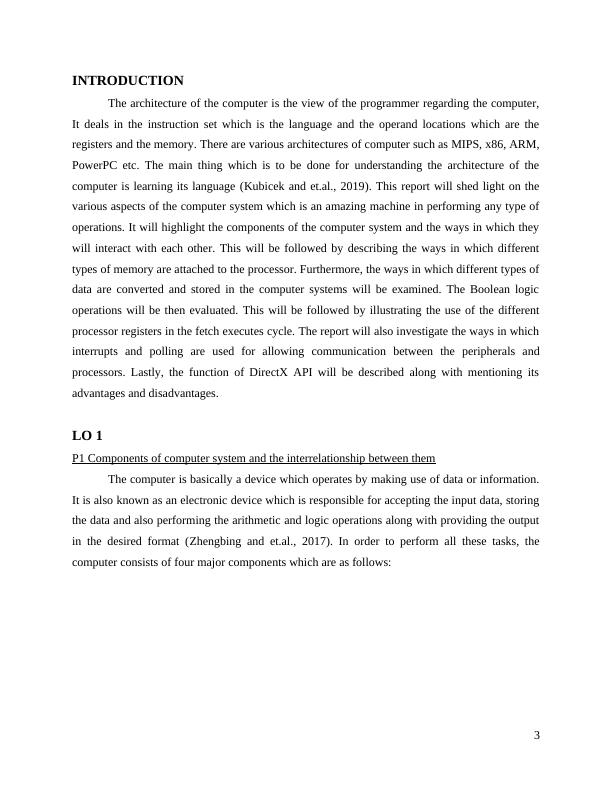
Figure 1: Components of computer system
Source: Components of computer system, 2021
Input Unit
This is formed by the input devices which are connected to the computer and are used for
interacting with the computer system or the data and also helps in entering the data and
instructions to the computer. These are responsible for converting the input data and the
instructions into binary form such as ASCII which is accepted by the computer. The examples of
the input devices which form the input unit are mouse, keyboard, scanner etc.
4
Source: Components of computer system, 2021
Input Unit
This is formed by the input devices which are connected to the computer and are used for
interacting with the computer system or the data and also helps in entering the data and
instructions to the computer. These are responsible for converting the input data and the
instructions into binary form such as ASCII which is accepted by the computer. The examples of
the input devices which form the input unit are mouse, keyboard, scanner etc.
4
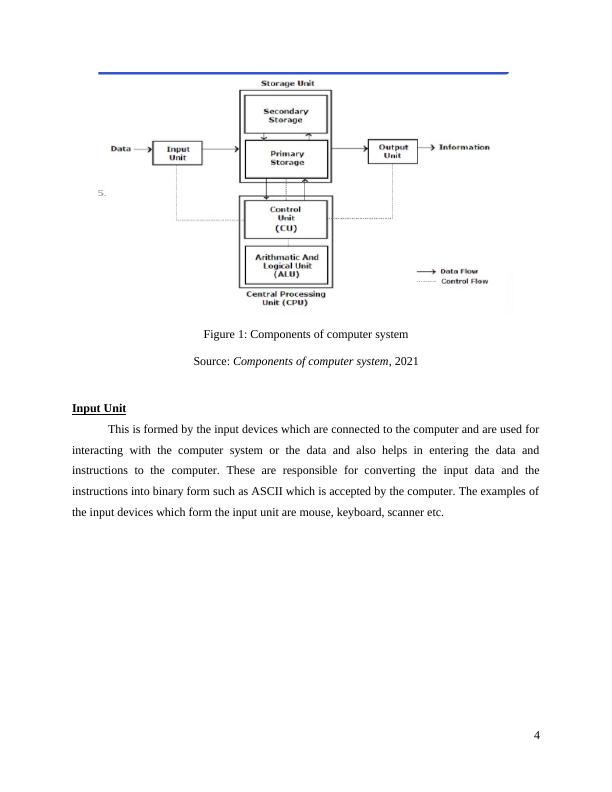
Figure 2: Input devices
Source: Input devices, 2021
Memory Unit
This unit is also known as storage unit. Before the actual processing of the data which are
entered, by making use of input unit needs to be stored on computer. The result is also stored
somewhere after processing before passing to the output units. All these functions are performed
by this storage unit and this also consists of two kinds of memory i.e., primary and secondary.
Primary Storage
This communicates directly with CPU and also enables the computer for storing the
temporary data and instruction. It is volatile which means it loses its content when the power
supply is off. Its example is Random Access Memory (RAM).
5
Source: Input devices, 2021
Memory Unit
This unit is also known as storage unit. Before the actual processing of the data which are
entered, by making use of input unit needs to be stored on computer. The result is also stored
somewhere after processing before passing to the output units. All these functions are performed
by this storage unit and this also consists of two kinds of memory i.e., primary and secondary.
Primary Storage
This communicates directly with CPU and also enables the computer for storing the
temporary data and instruction. It is volatile which means it loses its content when the power
supply is off. Its example is Random Access Memory (RAM).
5
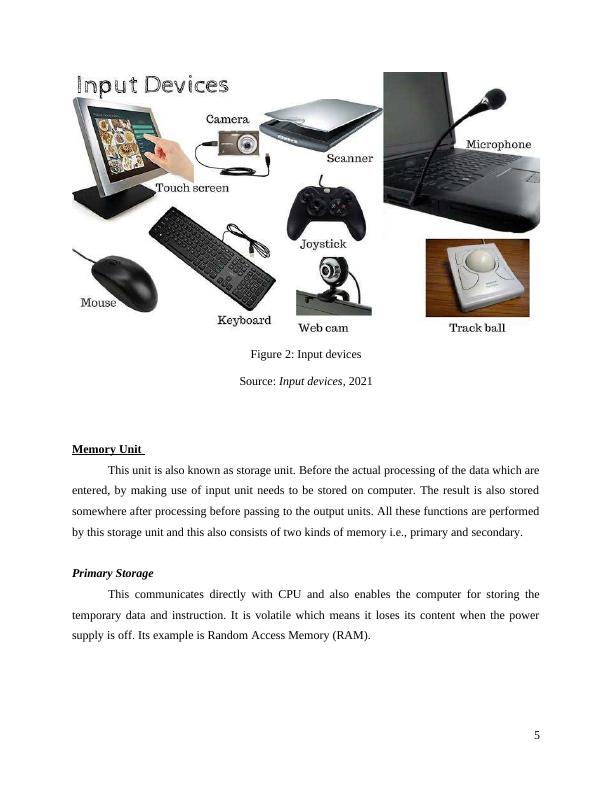
Figure 3: Random Access Memory
Source: Random Access Memory, 2021
Secondary Storage
This is also known as Auxiliary Storage which supplements the main memory. This is
non-volatile memory which helps in transferring the data from one computer to another. These
also play the role of backup devices which helps in storing the valuable information. Its
examples are Optical disk, Magnetic Disk etc.
Figure 4: Secondary Storage Devices
6
Source: Random Access Memory, 2021
Secondary Storage
This is also known as Auxiliary Storage which supplements the main memory. This is
non-volatile memory which helps in transferring the data from one computer to another. These
also play the role of backup devices which helps in storing the valuable information. Its
examples are Optical disk, Magnetic Disk etc.
Figure 4: Secondary Storage Devices
6
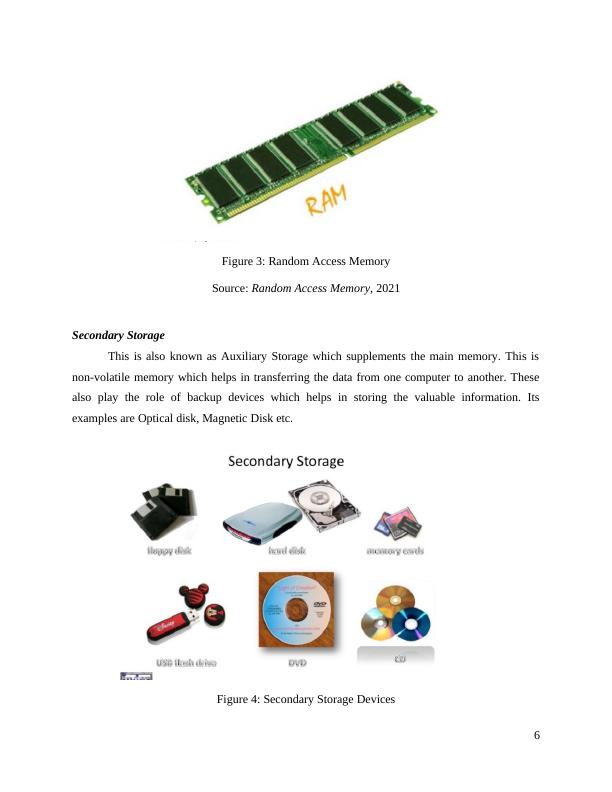
End of preview
Want to access all the pages? Upload your documents or become a member.
Related Documents
Architecture of Computer System: Components, Memory, and Data Conversionlg...
|28
|6487
|56
Computer System Architecture and Componentslg...
|32
|5654
|455
Computer System Architecturelg...
|23
|1375
|93
Examination of Computer System Componentslg...
|33
|10663
|81
Computer Architecture: Definition, Elements, and Evolutionlg...
|7
|1663
|454
Assignment On Computer Architecturelg...
|9
|2254
|280
